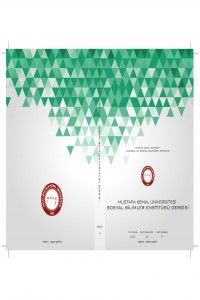İlköğretim 7. Sınıf Öğrencilerin Fene Karşı Meraklarının İncelenmesi/Investıgatıon of 7th grade elementary students' Scıence curıosıty
Özet Bu çalışmanın amacı, ilköğretim 7. sınıf öğrencilerin fene karşı olan meraklarını incelemektir. Çalışma, 2007 yılının Mart ayında Ankara'nın Gölbaşı ilçe merkezindeki üç devlet ilköğretim okulundan toplam 152 öğrenciyle gerçekleştirilmiştir. Veri toplama aracı olarak Harty ve Beall (1984)'in geliştirdiği fen merak ölçeği Türkçe'ye çevrilerek kullanılmıştır. Ölçüm aracının Türkçe versiyonunun Cronbach α güvenirlik katsayısı 0.87 olarak bulunmuştur. Ölçekten elde edilen veriler, aritmetik ortalamalar, iki yönlü ANOVA ve Pearson korelasyon katsayıları ile çözümlenmiştir. Analiz sonuçlarına göre öğrencilerin genel olarak fene meraklı oldukları söylenebilir. Türk, Meksikalı ve ABD'li öğrencilerin aynı ölçüm aracından aldıkları fen merak puanları karşılaştırıldığında Türk öğrencilerin merak seviyesinin daha yüksek olduğu görülmüştür. Kız öğrencilerin fen merak seviyesinin erkek öğrencilerden daha yüksek olduğu bulunmuştur. Ayrıca, akademik başarısı yüksek olan öğrencilerin akademik başarısı düşük olan öğrencilere göre fene karşı merak seviyelerinin daha yüksek olduğu sonucuna ulaşılmıştır. Son olarak, fen merak seviyesi ile akademik başarı arasında pozitif anlamlı bir korelasyon gözlenmiştir. Anahtar Kelimeler: Fen eğitimi, Merak, Akademik başarı, Cinsiyet INVESTIGATION OF 7TH GRADE ELEMENTARY STUDENTS' SCIENCE CURIOSITY Abstract The purpose of this study is to investigate 7th grade students' science curiosity. The current study was conducted in March 2007 in Gölbaşı district of Ankara by participation of 152 seventh grade students from three public elementary schools. As a measurement tool, “Children's Science Curiosity Scale” which was developed by Harty and Beall (1984) was used by translating it to Turkish. The reliability coefficient of Cronbach α was found to be 0,87 for Turkish version of the instrument. The data obtained from the instrument were analyzed through mean of the scores, two-way ANOVA and Pearson correlation coefficient. In general, it can be said that students are curious about science. When compared with the students from Mexico and USA, Turkish students get higher science curiosity score from the same instrument. It is found that science curiosity level of girls is higher than that of boys. Moreover, students with high academic achievement have higher science curiosity level than students with low academic achievement. Lastly, it is observed that there is a significant positive correlation between science curiosity level and academic achievement. Key Words: Science education, Curiosity, Academic achievement, Gender
Anahtar Kelimeler:
Fen eğitimi, Merak, Akademik başarı, Cinsiyet
___
- Kaynakça
- Alberti, E.T., & Witryol, S.L. (2001). “The relationship between curiosity and cognitive ability in third- and fifth-grade children”. The Journal of Genetic Psychology, 155 (2), 129-145.
- American Association for the Advancement of Science (AAAS). (1993). Benchmarks for Science Literacy. New York: Oxford University Press.
- Berlyne, D.E. (1954). “A theory of human curiosity”. British Journal of Psychology, 45, 180-191.
- Campbell, J.R. (1972). “Is Scientific Curiosity a Viable Outcome in Today's Secondary School Science Program?” School Science and Mathematics, 72 (2), 139-147.
- Carlin, K.A. (1999). “The impact of curiosity on learning during a school field trip to the zoo”. Dissertation Abstracts International, 60 (09), 3253A. (UMI No. 9945941)
- Coble, C.R., & Rice, D.R. (1983). “Rekindling scientific curiosity”. The Science Teacher, 50 (2), 48-50.
- Cohen, J., Cohen, P., West, S.G., & Aiken, L.S. (2003). Applied multiple regression/correlation analysis for the behavioral sciences. Third edition. Mahwah, New Jersey: Lawrence Erlbaum Associates, Publishers.
- Cunningham, G.K. (1998). Assessment in the classroom: constructing and interpreting texts. London: The Falmer Press.
- Diaz, M.O. (2006). “Middle school students science curiosity on both sides of the el paso/Juarez border”. Master Abstracts International, 44 (05). (UMI No. 1435452)
- Driscoll, E.A. (2004). “Fostering wonder and curiosity: immersion field trips in the Michigan 4-H children's garden”. Master Abstracts International, 43 (02), 386. (UMI No. 1422558)
- George, D. & Mallery, P. (2003). SPSS for windows, step by step, a simple guide and reference. Fourth edition. Boston: Allyn and Bacon.
- Green, S.B., Salkind, N.J., & Akey, T.M. (2000). Using SPSS for windows. Analyzing and understanding data. Second edition. New Jersey: Prentice Hall.
- Harty, H., & Beall, D. (1984). “Toward the development of a children's science curiosity measure”. Journal of Research in Science Teaching, 21 (4), 425-436.
- Harty, H., Beall, D., & Scharmann, L. (1985). Relationships between elementary school students' science achievement and their attitudes toward science, interest in science, reactive curiosity, and scholastic aptitude. School Science and Mathematics, 85 (6), 472-479.
- Krider, E. P. (2006). “Benjamin Franklin and lightning rods”. Physics Today, 59 (1), 42-48.
- Litman, J.A., & Spielberger, C.D. (2003). “Measuring epistemic curiosity and its diversive and specific components”. Journal of Personality Assessment, 80 (1), 75-86.
- National Research Council. (1995). National Science Education Standards. Washington, DC: National Academy Press.
- Opdal, P. M. (2001).” Curiosity, wonder and education seen as perspective development”. Studies in Philosophy and Education, 20, 331-344.
- Quartel, P. (2004). “The importance of curiosity and openness”. Teaching Science, 50 (3), 31.
- Reio, T.G., Jr., Petrosko, J.M., Wiswell, A.K., & Thongsukmag, J. (2006). “The measurement and conceptualization of curiosity”. The Journal of Genetic Psychology, 167 (2), 117-135.
- Seeger, R. J. (1973). Benjamin Franklin: New World Physicist. Oxford: Pergamon Press.
- Serin, G. (2009). Probleme Dayalı Öğrenme Öğretiminin 7. Sınıf Öğrencilerin Fen Başarısına, Fene Karşı Tutumuna ve Bilimsel Süreç Becerilerine Etkisi. Basılmamış doktora tezi. Orta Doğu Teknik Üniversitesi, Ankara, Türkiye.
- Talim ve Terbiye Kurulu Başkanlığı. (2006). İlköğretim Fen ve Teknolji Dersi (6, 7 ve 8. Sınıflar) Öğretim Programı. Ankara. Webden 30.11.2009 tarihinde alınmıştır.http://ttkb.meb.gov.tr/ogretmen/modules.php?name=Downloads&d_op=viewdownload&cid=74.
- Unal, H. (2005). “The influnce of curiosity and spatial ability on preservice middle and secondary mathematics teachers' understanding of geometry”. Dissertation Abstracts International, 66 (07), 2522A. (UMI No. 3183118)
- Başlangıç: 2004
- Yayıncı: Hatay Mustafa Kemal Üniversitesi
Sayıdaki Diğer Makaleler
